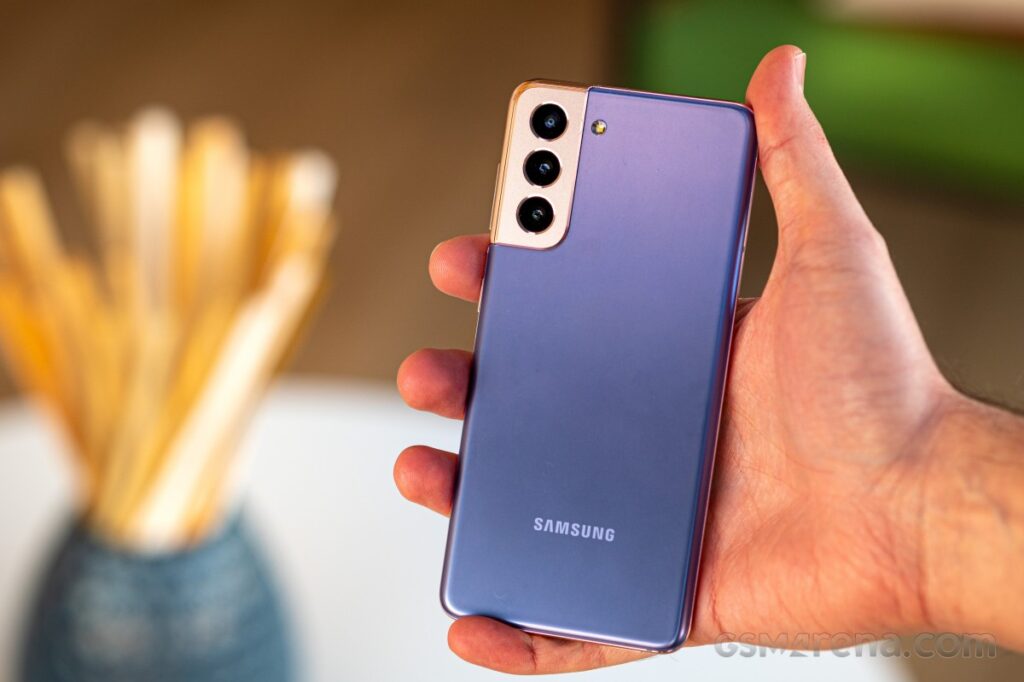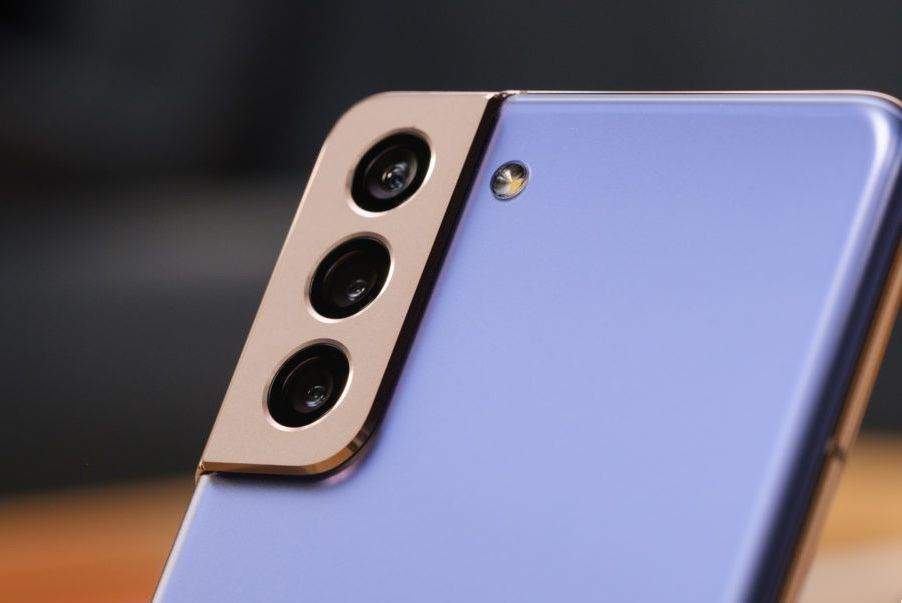On January the 14th Samsung unveiled their new flagship line-up – Galaxy S21, S21+ and S21 Ultra. Once again Samsung is giving us three flagship devices, at three different spec sheets and three different price points. The one we’re interested in today is the entry-level flagship, if you can call it that – Galaxy S21.
Coming in at $799, this is the cheapest Samsung flagship in recent years and that begs the question – why is that so? What did Samsung do to shave off a $100 compared to the last-years flagship S20 and is the phone actually worth the money? Let’s find out.
Design

Img source: gsmarena.com
First of all, let’s start with the design of the phone. Here we have a ‘compact’ 6.2-inch device coming in four different colourways: Phantom Grey, White, Pink and Violet. One thing that instantly catches your eye is the redesigned camera bump. It’s still here, it’s large and it will make your phone wobbly when you place in on the back, but this time around the bump wraps around the device in a seamless fashion making the transition between front and back fairly smooth.
Phantom Violet is easily the most eye-catching colourway of the quartet – with a matte, almost lavender coloured back and shiny, golden edges that are just smooth enough on the backside to provide a comfortable grip. Phantom White is also really good if you’re into the minimalist, clean look. The screen is flat, rather than curved as it was the case with the previous model – but we’ll get to the display in just a second. The left side of the device is tactile-button free, without the annoying Bixby button and the right side of the device carries a volume rocker and a power button.
A surprising thing is that the S21 is no longer a glass-back device. According to techspade.com, this time around the body of the device is made of polycarbonate, which is just a fancy word for plastic. Whether that’s a bad thing or not, we’ll have to wait and see, but it’s certainly one of those cut-backs that justify the price drop. It still looks and feels really premium though.
Display
https://www.youtube.com/watch?v=kYPHTSEU49Y&ab_channel=Samsung
At the first glance, you’re looking at an amazing 6.2 inch AMOLED screen with a peak brightness of 1300 nits. You have true-tone, rich colours, deep blacks and unless you’re standing in direct sunlight – you’re never going to use this phone at full brightness.
However, once you start getting into the spec sheet, you’ll notice another step in the opposite direction. Instead of 1440p panel, which was standard for a few generations of Galaxy phones at this point – S21 only has a 1080p display panel. In Samsung’s defence, the display is now an adaptive, HDR10+ capable, 120Hz panel and since you can’t really tell a difference in PPI at that screen size, what you’re really getting is an extremely smooth and fast experience of a 120Hz panel and rich colours. But, you can’t help but notice a trend of cutting down on some specs to fit $799 price tag.
On the bright side, the everlasting problem with Samsung devices, in-screen fingerprint sensor, seems to be finally dealt with. This year we’re getting 1.77 times larger and faster in-display, ultrasonic fingerprint sensor which should finally alleviate finger placement headaches all Galaxy owners had to endure for the last 2 years.
Camera

Img source: androidauthority.net
Don’t worry, there’s nothing backwards or skimped out on with camera modules on S21. We have a triple-camera setup – pretty standard for flagships nowadays, nothing too crazy or Pixel-esqe. As far as hardware goes – nothing has changed compared to S20. It’s still a 12MP main camera, 12MP ultra-wide and 64MP telephone lens capable of 3x optical zoom and gimmicky 30x digital zoom which no one ever uses. The main difference this year is in software, so you can expect even better images and performance, especially in night and portrait modes.
The same thing applies to the selfie camera. It’s still a hole-punch, 10MP camera – same sensor as last year, only with improved software. As always, S-series phones always deliver on camera quality, so once again, you can expect to take great images with this phone.
As far as video goes – you can record at 4K at 60 FPS on both front and back cameras – once again, pretty standard flagship stuff. As far as advertised 8K at 24 FPS goes, unless you’re shooting in an ideal setting light-wise – it just doesn’t look right. It’s a gimmick – you won’t use it more than once.
Battery

There were no changes to batter compared to the previous model, you still have a 4000 mAh battery, only this time, you have fewer pixels to push, as well as adaptive refresh rate – so you can expect even better results than last year. And if we consider that the last years’ results were excellent – you know what to expect from this one as well.
However, one thing is missing. You no longer have the option of 45W supercharging. This time you can only charge with up to 25W, which is arguably the biggest let-down as far as this phone goes. Losing the ability to charge your phone from 0 to 100% in under 45 minutes doesn’t really sit well with flagship users. Also, Samsung’s following the latest ecological (read: cutting down costs) trend, so you won’t be getting a charger in the box – you’ll have to get that separately if you don’t have one. Also, regardless of plastic back – the phone still supports 15W wireless charging and 4.5W reverse charging.
Chipset
Once again, we’re getting two different options CPU wise. The device will be running on the latest generation chipsets – Snapdragon 888 (US) or Exynos 2100 (rest of the world). How will these two stack up against each other and will there be any significant differences like there were last year – we don’t know. We’ll have to wait for the initial launch and hands-on testing to find out for sure, but we can’t imagine anything being wrong with these chips.
Memory
Once again, ‘low’ price comes at a spec cost. Galaxy S21, as well as S21 +, will only be equipped with 128 or 256 GB of internal storage and both of these models will come at 8 gigs of RAM. Now, internal memory has never been an issue when it comes to Galaxy phones because you always had the option of expanding it with a microSD, but this time around, you can’t do it. There’s no microSD slot on this device so you’re stuck with either 128 or 256 gigs. Bummer…
Final Thoughts – Is It Worth It?
In a word – absolutely. Even though Samsung has taken away some goodies, it’s still hard not to appreciate all the good things about this phone. If you’re willing to trade in some pixels for refresh rate, use an old charging brick instead of a new one and look past the plastic back – then this phone is absolutely perfect for you. You won’t find a better deal anywhere else.



